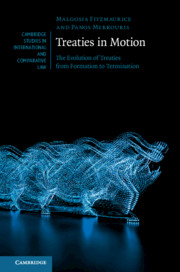Book contents
- Treaties in Motion
- Cambridge Studies in International and Comparative Law: 149
- Treaties in Motion
- Copyright page
- Contents
- Figures
- Tables
- Acknowledgements
- List of Abbreviations
- Table of Cases
- Table of Treaties
- 1 Motion as a Notion
- 2 Treaty Genesis
- 3 Consent to Be Bound
- 4 Treaty Interpretation and Its Rules
- 5 Amendment/Modification/Revision of Treaties
- 6 Treaties and Their Phthora
- 7 Concluding Remarks
- Bibliography
- Index
- Cambridge Studies in International and Comparative Law
5 - Amendment/Modification/Revision of Treaties
Motion as Change
Published online by Cambridge University Press: 05 June 2020
- Treaties in Motion
- Cambridge Studies in International and Comparative Law: 149
- Treaties in Motion
- Copyright page
- Contents
- Figures
- Tables
- Acknowledgements
- List of Abbreviations
- Table of Cases
- Table of Treaties
- 1 Motion as a Notion
- 2 Treaty Genesis
- 3 Consent to Be Bound
- 4 Treaty Interpretation and Its Rules
- 5 Amendment/Modification/Revision of Treaties
- 6 Treaties and Their Phthora
- 7 Concluding Remarks
- Bibliography
- Index
- Cambridge Studies in International and Comparative Law
Summary
Chapter 5 on amendment, modification, and revision is organically linked with the former chapter on interpretation. It deals with the possibility of a temporal motion of a treaty through amendment, modification or revision. This may lead to either increase (auxesis), diminution (meiosis), or even alteration (alloiosis) of a treaty. The chapter goes through the development of the rules of amendment and modification in the VCLT, and also examines the contemporary development of the law of treaties through conferences of parties established by multilateral environmental agreements. This practice has led to new approaches to treaty modification, which did not exist in classical international law. It may be said that such modifications are effected through secondary legislation, which in turn may lead to the questions of legitimacy. This chapter concludes with an examination of the patterns of amendment and modification that emerge from the multilateral treaties that have been registered in the League of Nations and United Nations Treaty Series.
Keywords
- Type
- Chapter
- Information
- Treaties in MotionThe Evolution of Treaties from Formation to Termination, pp. 182 - 269Publisher: Cambridge University PressPrint publication year: 2020

